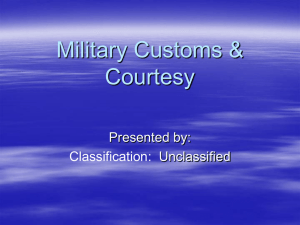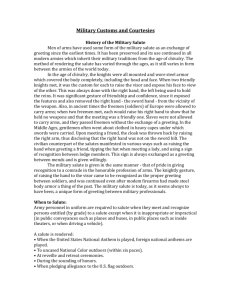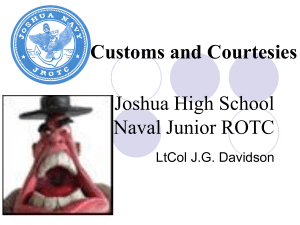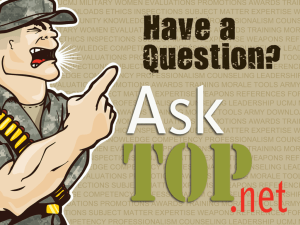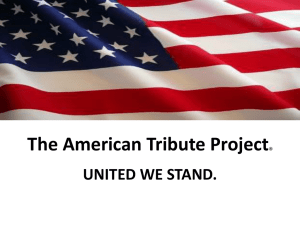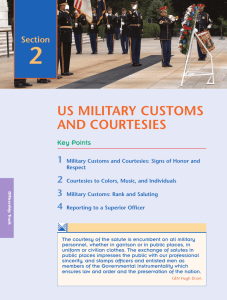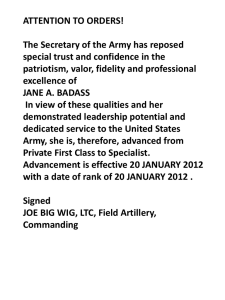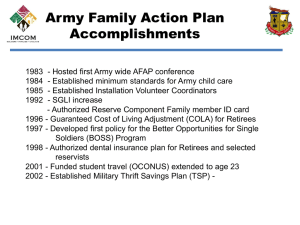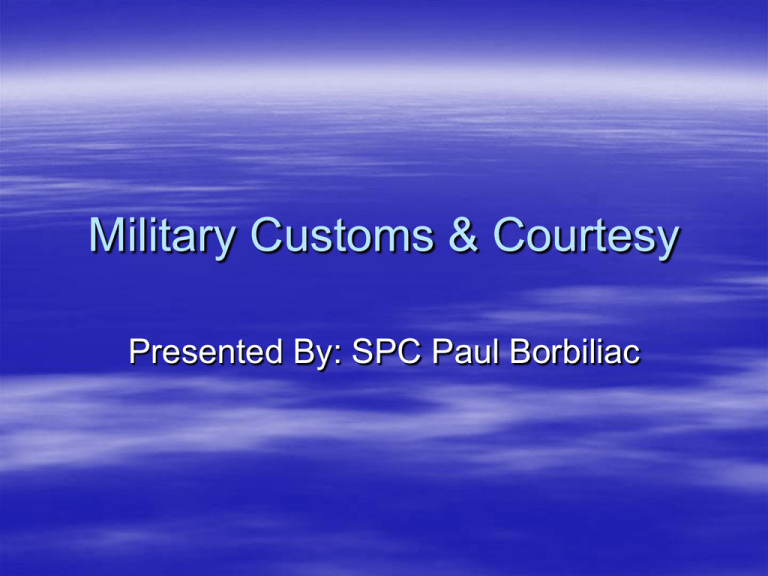
Military Customs & Courtesy
Presented By: SPC Paul Borbiliac
Title
Outline
Meanings of Customs & Courtesy
Examples of Customs
Examples of Courtesies
The Hand Salute
Origin and Meaning
Appropriate and Non-Appropriate examples of Saluting
Walking with and addressing Officers and NCOs
Identifying Ranks
Common rules
Acknowledging High Ranking Officers and NCOs entering the DFAC
Crowded Hallways and Similar areas
Saluting and Reporting to an Officer, NCO, or Board
Walking with an Officer/NCO
Rendering Honors to U.S. Flag, and specific National/Military Music
U.S. Flag
Actions upon raising and lowering the Flag
National/Military music
National Anthem
Retreat
Reveille
Taps
The Army Song
Conclusion
Questions
The Meanings of Customs & Courtesies
Customs
Established Practice; includes both
positive and negative actions.
Compliment procedures required by
military courtesy.
Add to the graciousness of garrison life.
Courtesies
Good manners and politeness in
dealing with other personnel.
Respect and consideration shown to
each other by members of the same
profession.
Basis for good human relations.
Indicator of person’s bearing, discipline,
and manners.
The difference between military courtesy and customs is that military
courtesy are the Rules of Conduct required of military personnel either by
regulation or tradition. Customs of the service are practices and
procedures not prescribed by law or regulation, but by tradition and
practice have become of a binding force.
Examples of Customs
Never criticize the Army or a leader in public
Never jump the chain of command
Never offer excuses
Never use a superiors rank to get something done, when in fact the
superior never gave such a order (“First Sergeant wants this done
now.”)
Never turn and walk away to avoid giving the hand salute
Never run indoors or pretend you don’t hear (while driving) to avoid
standing during Reveille or Retreat
Never appear in uniform while under the influence of alcohol
You will never go wrong with the response," I don’t know, but I’ll find
out.” if you don’t know the answer to a superiors question.
Examples of Courtesies
Hand Salute
Addressing and working with Commissioned
and Non-Commissioned Officers
Rendering honors to the Flag
Reacting and rendering honors to specific
National/Military music
The Hand Salute
Origin and Meaning
•
•
In the late Roman times
assassinations were common. A
citizen who wanted to see a public
official would approach with his right
hand raised to show he did not hold a
weapon.
In the century of Knights in Armor,
knights raised their visors with the
right hand when meeting a comrade.
Honor exchange, privilege gesture of
respect and trust among soldiers,
and recognition of each others
commitment, abilities, and
professionalism; sign of selfdiscipline.
Expression that recognizes each
other as a member of the “Profession
of Arms”; that they have made a
personal commitment of self-sacrifice
to preserve our way of life.
Appropriate and Non-Appropriate Examples of Saluting
Appropriate
When in uniform
When National Anthem, To the Colors, Hail
to the Chief, Foreign National Anthems are
played
Funerals/Change of Commands
Retreat or Reveille
Sounding of Honors
Pledging of Allegiance to the U.S. flag
(outdoors)
Turning over control of formations
When rendering reports
Officers of friendly foreign countries
Reporting for pay
Non-Appropriate
Indoors (unless you are reporting to a
Officer, Board, or if you are on guard
duty)
A prisoner
If you are working underneath a vehicle
Either the senior or subordinate is
wearing civilian clothes
Either the senior or subordinate has
articles in both hands
When unit is resting alongside a road
(road marches)
The salute should be accompanied with an appropriate greeting, such as,
“Good morning/afternoon, sir/ma’am.” or the units motto. Remember to
salute proudly because it shows you have pride in yourself and your outfit
and that you have confidence in your abilities as a soldier.
Working with and Addressing Officers and
NCOs
Identifying Ranks
NCO- enlisted person,
as a sergeant or
corporal, holding any
of various ranks below
commissioned or
warrant officers
Commissioned Officer- a
military or naval officer
holding rank by
commission.
Common Rules
Officers
When speaking to an
Officer stand at attention
until ordered otherwise
When dismissed, come to
attention and salute
When a Officer enters a
room, the first soldier to
recognize him calls the
room to attention
An Officer is always
addressed as Sir/Ma’am
depending on the sex.
NCOs
When speaking to an NCO
stand at parade rest until
ordered otherwise
When an NCO of a
superior rank enters a
room, the first soldier to
recognize him calls the
room to at ease
Always greet or address
the NCO with the
appropriate title
(“Sergeant/SergeantMajor)
Acknowledging High Ranking Officers and NCOs in the Mess Hall
When an Officer/NCO enters a dining facility, unless he directs
otherwise or unless a more senior officer is already present, the diners
will be given the order “at ease” by the first person who sees the
Officer/NCO. You will remain seated at ease and will continue eating
unless the Officer/NCO directs otherwise. If you are directly addressed,
you should rise to attention if seated in a chair. If seated on a bench,
stop eating and sit at attention until the conversation has ended.
Crowded Hallways and Similar Areas
When a Officer/NCO
enters a crowded hallway
or similar area where
troops are taking a break
or standing in a waiting
line, the first person to see
the Officer/NCO should
call “At ease” and “Make
way” so those present will
move to the sides of the
hallway and allow
passage.
Saluting and Reporting to an Officer, NCO, or Board
Always salute 6 paces away, or until you
can see the rank of the Officer
On certain occasions enlisted will salute
enlisted personnel (When reporting, handing
over formation, rendering a report, reporting
to a board)
You will always hold the salute until the
person you are saluting returns the salute
Reporting
When you report to an Officer/NCO/Board,
approach the person on whom you are
reporting to and stop about two steps from
him, assuming the position of attention.
Give the proper salute and say, for example,
“Sir/Ma’am, Private Smith reports as
ordered.” When business is conducted and
you are dismissed, come to attention and
salute wait for the return salute, once
acknowledged execute the proper facing
procedure and leave the room.
Walking with a Officer/NCO
When walking with a superior, always walk
on the left.
The custom of walking to the left originated
in the middle ages when a person carries
his weapon in his right hand and was
considered the right to be a part of honor;
the person to his left protected the
unguarded side.
Rendering Honors to the U.S. Flag,
National/Military music
U.S. Flag
The flag of the United
States is the symbol of
our nation. The union,
white stars on a field of
blue, is the honor point
of the flag
All soldiers should pay
respect to the flags
daily, when it is being
raised and when it is
being lowered.
Action upon raising and lowering of the flag
Whenever and wherever the “National
Anthem”, “To The Colors”, “Hail to the Chief”,
or “Reveille” are played, at first note, all
dismounted personnel in uniform and not in
formation face the flag or the music (if the flag
is not in view), stand at Attention and renders
a salute
When not in uniform, personnel will, at first
note, stand at attention facing the flag or the
music (if the flag is not in view), remove
headgear, if any, with the right hand, and place
the right hand over the heart.
Vehicles in motion will be brought to a halt.
Persons riding in a passenger car or on a
motorcycle will dismount and salute.
Occupants of other types of military vehicles
and buses remain seated at attention in the
vehicle, the individual in charge of each
vehicle dismounting and rendering the hand
salute. Tank and armored car commanders
salute from the vehicle.
National/Military Music
National Anthem
Reveille
Retreat
To the Colors
Hail to the Chief
Taps
The Army Song
National Anthem
Known as the “StarSpangled Banner”
Written by Francis
Scott Key
Usually played after
Retreat
Upon hearing, soldiers will come to attention
and salute the flag or the direction of the
music.
Retreat
Originally called “The
Watch Setting”
Signal to forces outside
the camps to return before
the closing of the gates
Originally sounded on
drums
Adopted to take effect
before sunset in 1779
Signal of when the night
guard was taking control
Upon hearing, soldiers will come to attention
face the flag or the music and wait to
salute.
Reveille
Originally from the French
meaning “to wake again”
Written by Joseph Hayden
Signifies the beginning of
the duty day
Origins from the Roman
Empire “Diana’s Hymn”
Upon hearing, soldiers will come to attention
face the flag or the direction of the music
and stand at attention and wait to salute.
Taps
Meaning “Lights Out”
Created in July of 1862
by union Gen. Daniel
Adams Butterfield
Played by the Brigade
bugler Oliver Wilcox
Norton
Officially recognized in
1874
The Army Song
March along, sing our song
with the Army of the free
Count the brave,
count the true,
who have fought to victory.
We're the Army and proud of our name;
We're the Army and proudly proclaim:
First to fight for the right, and to build the Nation's might,
And the Army Goes Rolling Along
Proud of all we have done,
Fighting till the battle's won,
And the Army Goes Rolling Along
CHORUS:
Then it's hi, hi, hey! The Army's on its way
Count off the cadence loud and strong (two, three)
For wher-e'er we go, You will always know
that the Army Goes Rolling Along
Valley Forge, Custer's ranks, San Juan hill and Patton's tanks,
And the Army went rolling along.
Minute men from the start,
Always fighting from the heart,
And the Army keeps rolling along.
CHORUS
Men in rags, men who froze, still that Army met its foes,
And the Army went rolling along.
Faith in God, then we're right,
And we'll fight with all our might,
As the Army keeps rolling along.
CHORUS (the third chorus should be sung slower) + (Keep it rolling) And
The Army Goes Rolling Along.
Upon hearing, soldiers should come to attention face
the flag or the direction of the music and salute.
Conclusion
Military Customs & Courtesies is not a one-way
street. Enlisted personnel must be courteous to
Officers, and Officers are expected to return the
courtesy. Officers respect the soldiers as
individuals, just as you respect the Officers as
individuals. Without the basis of mutual respect
the can be no Military Customs & Courtesy, and
disharmony will result.
Customs & Courtesy show discipline, bearing, and
the abilities of the Unit, soldier, and Section. Pride
in ones actions will show positive Courtesy and
Custom.
???Questions???
Work-Cited Page
FM 3-21.5 Drill & Ceremony
FM 7-21.13 The Soldiers Guide
AR 600-20 Army Command Policy
AR 600-25 Salute, Honors, Visits of Courtesy
August 1995 Webster’s Handy College Dictionary 3rd
Edition
Internet Sites
www.armystudyguide.com
www.squad-leader.com

